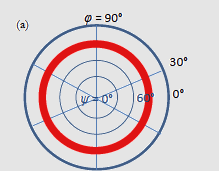
Stress and Texture
Texture is the distribution of crystallographic orientations of a polycrystalline sample. The degree of texture can range from completely random (powder sample), weak, moderate of strongly textured. Quantitative analysis can be performed to measure the amount of texture and the orientation in the different direction.


Texture is created by slight mis-orientations of different crystals as they grow on the substrate.
- The crystals can be slightly misoriented along the C-direction, which will be measured by the theta /rocking scan around the 00.2.
- The crystal can be misoriented in the plane, which will result in:
- Ring of scattering around the 10.3. Completely random orientation
- Partial texture. Serie of peaks in the phi scan around 10.3
Texture is often represented by using pole figures.
The texture around an asymmetric reflection provides information about the in-plane epitaxial relation


Phi-scan showing the 6-fold symmetry in a case of hexagonal high-ordered AlScN layer on Si(111) substrate

There are also other more modern and faster methods taking advantage of 2D and 1D detectors and reciprocal-space representation.
Reciprocal-space map in a case of texture

Residual stresses in materials can arise during different processing, e.g heat treatement or machining. In measuring residual stress using X-ray diffraction, the strain in the crystal lattice is measured first as shifts of the Bragg peaks and the associated residual stress is determined then from the elastic constants assuming a linear elastic response.
